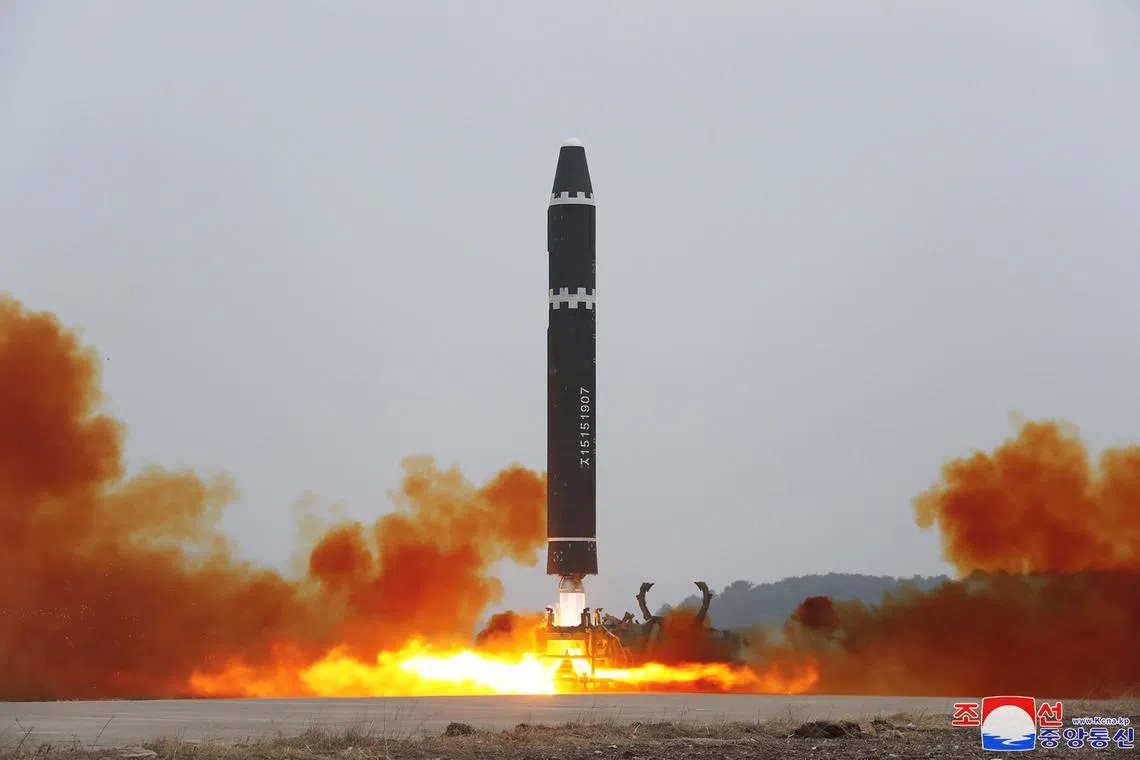North Korea confirms testing long-range missile, touts ‘fatal nuclear counter-attack’ capabilities
Sign up now: Get insights on Asia's fast-moving developments

North Korea launched a long-range ballistic missile into the sea off Japan’s west coast on Saturday afternoon.
PHOTO: EPA-EFE
Follow topic:
SEOUL – North Korea said on Sunday it had tested a Hwasong-15 intercontinental ballistic missile (ICBM) the previous day in a “sudden launching drill” that confirmed its readiness for “mobile and mighty counter-attack” against hostile forces.
North Korea launched a long-range ballistic missile into the sea off Japan’s west coast
“The surprise ICBM launching drill...is an actual proof of the DPRK strategic nuclear force’s consistent efforts to turn its capacity of fatal nuclear counterattack on the hostile forces into the irresistible one,” state news agency KCNA said. DPRK stands for North Korea’s official name, the Democratic People’s Republic of Korea.
In a separate statement on Sunday, North Korean leader Kim Jong Un’s sister, Ms Kim Yo Jong, bristled at the US for trying to turn the United Nations Security Council into what she called a “tool for its heinous hostile policy” towards Pyongyang.
“I warn that we will watch every movement of the enemy and take corresponding and very powerful and overwhelming counteraction against its every move hostile to us,” she said.
In response, the US and South Korea deployed strategic bombers in a show of force after North Korea launched an intercontinental ballistic missile that added to tension in the region.
The two allies flew B-1B bombers escorted by their fighter jets on Sunday in a joint air drill, the Joint Chiefs of Staff in Seoul said in a text message. The aircrafts entered South Korea’s air defense identification zone.
The US and Japan plan to conduct a joint air drill on Sunday in response to North Korea’s launch, broadcaster FNN separately reported earlier, citing several unidentified people with knowledge of the matter.
The exercise will be held near Japan and include US bombers and Japan Air Self-Defense Force fighter jets, FNN said, adding that the drill is contingent on weather conditions.
It wasn’t clear whether the drill would combine with the US-South Korea one, which also involved F-35A, F-15K and F-16 fighter jets according to the JCS. South Korea didn’t say how many B-1B bombers the US deployed in their drill.
In comments carried by state media on Sunday, Kim Yo Jong, the sister of North Korean leader Kim Jong Un, issued new warnings to the US, saying Washington should “stop all the actions posing threats to the security of our state.”
Saturday’s missile test, the North’s first missile firing since Jan 1, came after Pyongyang threatened on Friday an “unprecedentedly persistent, strong” response as South Korea and the US gear up for annual military exercises as part of efforts to fend off the North’s growing nuclear and missile threats.
The state news agency said the missile had flown for 1 hour, 6 minutes and 55 seconds, as high as 5,768km, before accurately hitting a pre-set area 989km away in open waters. Hwasong-15 was first tested in 2017.
Japan said on Saturday the missile had plunged into waters inside its exclusive economic zone.
‘Without warning’
Nuclear-armed North Korea fired an unprecedented number of missiles last year, including ICBMs capable of striking anywhere in the US, while resuming preparations for its first nuclear test since 2017.
South Korean Foreign Minister Park Jin said Saturday’s launch “clearly” signals the North’s intent to conduct additional provocations.
“If North Korea conducts the seventh nuclear test, which could happen at any time, it will be a game changer in a sense that North Korea could develop and deploy tactical nuclear missiles,” Mr Park told the Munich Security Conference on Saturday.
The launch, guided by the Missile General Bureau, was conducted on an “emergency firepower combat standby order” given at dawn, followed by a written order by Mr Kim at 8am (2300 GMT on Friday), the KCNA said. South Korea’s military said it detected the missile at 5.22pm (0822 GMT).
“The important bit here is that the exercise was ordered day-of, without warning to the crew involved,” said Mr Ankit Panda, a missile expert at the US–based Carnegie Endowment for International Peace. “The amount of time between the order and the launch is likely going to be decreased with additional testing.”
The military unit got an “excellent mark” over the test and the North’s ruling party “highly appreciated the actual war capacity of the ICBM units which are ready for mobile and mighty counterattack”, KCNA added.
Analysts say North Korea is likely to conduct more weapons tests, including a possible new solid-fuel missile, which could help the North deploy its missiles faster in the event of a war.
North Korea’s ballistic missile and nuclear weapons programmes are banned under UN Security Council resolutions, but Pyongyang says its weapons development is necessary to counter “hostile policies” by Washington and its allies. REUTERS, BLOOMBERG

